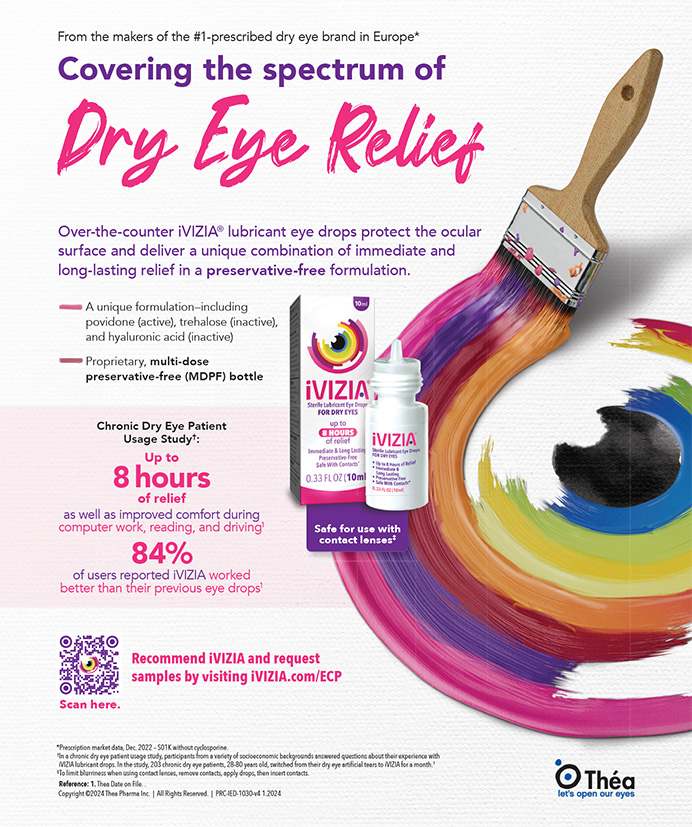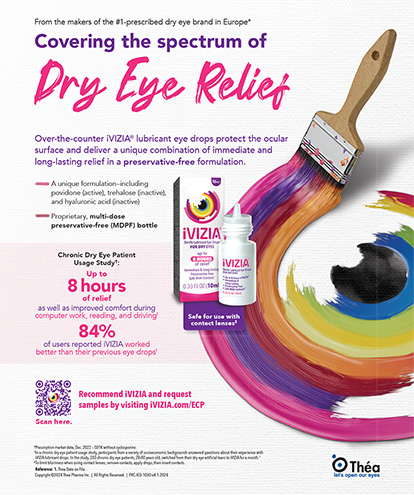

Treatment of glaucoma is targeted at reducing IOP. Owing to the risk of complications, incisional surgery was traditionally reserved for advanced cases that were refractory to conservative management. With recent advances in surgical technique, however, the role of surgical intervention in the management of glaucoma has changed.
Cataract Surgery
Patients with the most common forms of chronic glaucoma tend to be of demographics similar to those requiring cataract surgery. Determining the appropriate surgery to perform in a patient with glaucoma and significant cataracts can be a challenge. Phacoemulsification has been shown to yield significantly better outcomes in acute and chronic angle-closure glaucoma than previously believed,1 but the risk of postoperative IOP spikes remains a concern even after uneventful phacoemulsification.
AT A GLANCE
- The classic teaching in glaucoma has been to reserve surgical procedures for advanced cases. With recent developments, the role of surgical intervention has increased drastically.
- If the goal is attaining a modest reduction in IOP or maintaining a current medical regimen, phacoemulsification alone may be appropriate for patients with very mild open-angle glaucoma or in eyes with preexisting functional blebs.
- Ab interno glaucoma procedures have recently gained popularity because they have the ability to lower IOP while preserving the conjunctiva. Endoscopic cyclophotocoagulation and smaller implants that bypass a small region of the trabecular meshwork are usually combined with phacoemulsification and are reserved for mild to moderate cases.
- With the development of the micropulse diode laser, transscleral cyclophotocoagulation has an expanded role in the treatment of glaucoma. The risks are lower, and the treatment is gentler, allowing the procedure to be used in a wider range of disease states.
If the goal is attaining a modest reduction in IOP or maintaining the current medical regimen, phacoemulsification alone may be appropriate for patients with very mild open-angle glaucoma or in eyes with preexisting functional blebs. In patients with angle-closure glaucoma, the need for additional medications or further incisional surgery for IOP control after phacoemulsification is low; however, the risk must still be discussed. Thus, with the exception of eyes with moderate or advanced glaucoma, performing phacoemulsification as a standalone procedure is reasonable in these cases.1
Ab Interno Glaucoma Procedures
Ab interno glaucoma procedures have recently gained significant popularity because they have the ability to lower IOP while preserving the conjunctiva. Similar to classic glaucoma procedures, they either increase the outflow of aqueous or decrease its production. Numerous devices and techniques in this area have been developed. In general, endoscopic cyclophotocoagulation and small implants that bypass a small region of the trabecular meshwork are usually combined with phacoemulsification and are reserved for mild to moderate disease with the goal of reducing reliance on antiglaucoma medications. Reductions in medication can have a profound impact on a patient’s quality of life. Some time may pass before increased therapy is needed, translating to years of extra vision with minimal risk.
In eyes with moderate to advanced glaucoma that require more significant reductions in IOP, procedures that result in the bypass of a larger region of the trabecular meshwork can be considered. These include the Trabectome (NeoMedix), Kahook Dual Blade (New World Medical), gonioscopy-assisted transluminal trabeculotomy, and Trab360 (Sight Sciences). These procedures are capable of unroofing large areas of trabecular meshwork, yielding significant pressure reductions in eyes that may otherwise require traditional surgery. Since most of these procedures do not produce an external reservoir, there is no concern about bleb-related complications. Patients are not precluded from wearing contact lenses after these procedures, making them ideal for individuals who are heavily reliant on them. These procedures’ ability to produce significant IOP reductions could delay or even eliminate the need for classic filtering surgery and preserve the full conjunctival real estate.
Filtering Procedures
Filtering or shunting procedures continue to be used in advanced disease that requires significant IOP lowering. Ample literature exists to demonstrate their long-term efficacy. The downside, however, is the potential for bleb-related complications and the need for activity restrictions. Because the treatment of glaucoma is focused on stabilizing the optic nerve and visual field, trabeculectomy with an antimetabolite is a reasonable first-line filtering procedure in most circumstances. The recent development of the Xen45 Gel Stent (Allergan) allows this procedure to be performed through an ab interno approach, although long-term data on the Xen remain limited.
Placement of a glaucoma drainage device (GDD) can be performed as a primary or a subsequent procedure. Although tube placement can be performed primarily, superotemporal placement precludes future filtering surgery. Despite favorable results with GDD implantation in the Tube Versus Trabeculectomy (TVT) study,2 primary tube implantation can translate to significant complications. Therefore, therapy should be tailored to the individual, especially in patients with specific circumstances such as neovascular glaucoma or poor tissue quality.
Cyclodestructive Procedures
Due to the risks of transscleral cyclophotocoagulation, the procedure is generally reserved for eyes with end-stage glaucoma and poor visual prognosis. With the development of micropulse transscleral cyclophotocoagulation (MP-TSCPC) with diode laser, there is a trend to perform MP-TSCPC in eyes with earlier disease states.
It has been proposed that alternative mechanisms of IOP reduction are at work in MP-TSCPC, including increased uveoscleral outflow3 and increased trabecular outflow4 by enlargement of extracellular matrix spaces, rather than true cyclodestruction. It is important to note that MP-TSCPC is not without complications and that lighter settings are recommended for use in earlier disease to reduce the risk of problems such as phthisis.
Putting It Together
The most common forms of glaucoma are chronic diseases that currently cannot be cured. Therefore, treatment is aimed at delaying the onset of blindness and maintaining the patient’s quality of life. The classic teaching in glaucoma has been to reserve surgical procedures for advanced cases. With the recent development of ab interno procedures, however, the role of surgical intervention has increased drastically, working in synergy alongside medications for a wide range of disease severity. In a disease without a known cure, having a treatment algorithm as outlined in The Road to Treatment optimizes the amount of time patients can maintain vision.
1. Chen PP, Lin SC, Junk AK, et al. The effect of phacoemulsification on intraocular pressure in glaucoma patients: a report by the American Academy of Ophthalmology. Ophthalmology. 2015;122(7):1294-1307.
2. Gedde SJ, Schiffman JC, Feuer WJ, et al. Treatment outcomes in the Tube Versus Trabeculectomy (TVT) study after five years of follow-up. Am J Ophthalmol. 2012;153(5):789-803 e2.
3. Aquino MC, Barton K, Tan AM, et al. Micropulse versus continuous wave transscleral diode cyclophotocoagulation in refractory glaucoma: a randomized exploratory study. Clin Exp Ophthalmol. 2015;43(1):40-46.
4. Johnstone M, Padilla S, Wen K, et al. Transscleral laser induces aqueous outflow pathway motion and reorganization. Poster presented at: The 25th Annual AGS Meeting; March 2, 2017; Coronado, CA.




